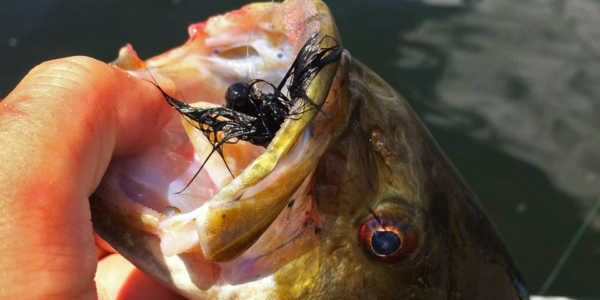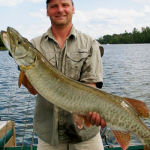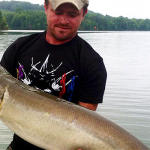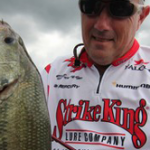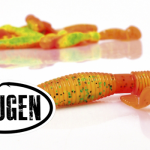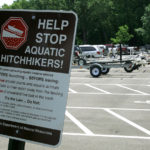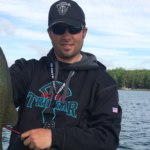By Adam M. Glickman
Mayfly and other insect hatches are often thought of in a very negative manner by summertime fishermen who fail to produce good results when these forage abundances occur. Common thought is that fish gorge themselves on the heavy presence of insects and become too “full” to eat any more.
It is true that crappies, bluegills, yellow perch, largemouth bass, smallmouth bass, walleyes, brown trout, and brook trout will feed heavily on emerging larvae and adult mayflies, especially the large and abundant hexagenia types of summer, and they often do become less active for a short time after the brief frenzy of the hatch is over, but during the actual hatch, some of the best fishing of the summer can be had for all species by using tactics that adjust to food chain shifts caused by these massive yet brief lower link forage introductions. In many cases, when the time is right, this will allow fishermen to tap into the food chain and experience some of the best action of the season. The keys to this success are understanding insect hatches (which are extremely complex), understanding the changes they create in aquatic food chains, and understanding and implementing successful tactics that take advantage of the shifts in gamefish feeding behaviors during these times.
The Mayfly Life Cycle. Illustration 1.
Mayflies usually live in annual life cycles of which the larval or nymph stage is the majority of that time and the adult stage is very short (usually 1-2 days). There are many different types of mayflies and many different types will make up different populations with their own separate life cycles in any one lake, reservoir, river, or stream. Also, there may be different populations of the same type within the same water that are on different life cycle schedules (and therefore emerge at different times throughout the summer).
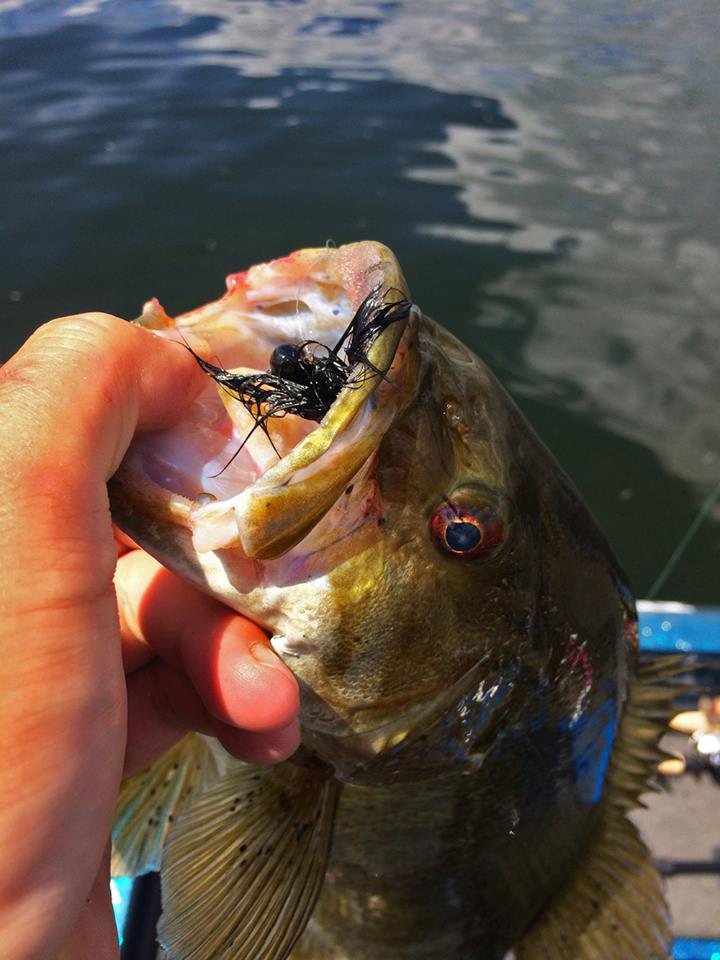 When swarms of mayflies are seen above the water flying every which way, this a mating swarm of the most adult form of mayflies which are called “spinners”. Shortly after this, females drop their eggs into the water while flying just above the surface or landed on the surface. The eggs settle to the bottom and incubate usually from a few days to a few months depending on water temperature, other conditions ,and the specific species. Once hatched, larvae (nymphs) live near the bottom under rocks or within decaying vegetation and feed on decaying vegetation or other organic material. The nymph stage usually lasts several months to almost a full year. Just before the nymph molts into the dun (essentially the first adult stage), it swims to the surface where it rests while the dun emerges from the “shell” of the nymph, which then becomes nothing but an empty husk floating on the surface, of which thousands can be seen collected by the wind after a hatch. This is when the feeding frenzies begin as `panfish, bass, trout, minnows, chubs, ciscoes, and even walleyes feed on nymphs as they near the surface and rest on it. The frenzy continues as the duns must rest motionless on the surface unable to fly away until their wings dry (which can take a few minutes to a few hours depending on conditions). This frenzy can be seen in vast areas across the surface of lakes as the water appears to boil from fish eating helpless duns before their wings can dry. Once a dun’s wings dry, it flies from the surface and usually lands in trees near the shore of the lake or river where thousands can often be seen covering trees. From here the duns molt a second time (mayflies are of the few insects that molt twice) and turn into the sexually mature spinners. The husks from this stage are often seen plastered in huge numbers to lakeside trees and buildings. The sexually mature spinners mate, the females lay their eggs, the spinners die, and the cycle is complete. When the females land on the surface to deposit their eggs, another frenzy occurs, but it is not usually as intense as the emerge frenzy. However, it is usually easily found because it often takes place directly below the swarms of spinners that are easily seen often from a great distance away. Often in the past, these swarms have been so large and dense over the Great Lakes that they have been detected by Doppler radar. Heavy swarms of mayflies are also indicative of a healthy water body and surrounding watershed. The declining intensity of mayfly hatches over the last 15-30 years is likely due to the increased use of pesticides.
When swarms of mayflies are seen above the water flying every which way, this a mating swarm of the most adult form of mayflies which are called “spinners”. Shortly after this, females drop their eggs into the water while flying just above the surface or landed on the surface. The eggs settle to the bottom and incubate usually from a few days to a few months depending on water temperature, other conditions ,and the specific species. Once hatched, larvae (nymphs) live near the bottom under rocks or within decaying vegetation and feed on decaying vegetation or other organic material. The nymph stage usually lasts several months to almost a full year. Just before the nymph molts into the dun (essentially the first adult stage), it swims to the surface where it rests while the dun emerges from the “shell” of the nymph, which then becomes nothing but an empty husk floating on the surface, of which thousands can be seen collected by the wind after a hatch. This is when the feeding frenzies begin as `panfish, bass, trout, minnows, chubs, ciscoes, and even walleyes feed on nymphs as they near the surface and rest on it. The frenzy continues as the duns must rest motionless on the surface unable to fly away until their wings dry (which can take a few minutes to a few hours depending on conditions). This frenzy can be seen in vast areas across the surface of lakes as the water appears to boil from fish eating helpless duns before their wings can dry. Once a dun’s wings dry, it flies from the surface and usually lands in trees near the shore of the lake or river where thousands can often be seen covering trees. From here the duns molt a second time (mayflies are of the few insects that molt twice) and turn into the sexually mature spinners. The husks from this stage are often seen plastered in huge numbers to lakeside trees and buildings. The sexually mature spinners mate, the females lay their eggs, the spinners die, and the cycle is complete. When the females land on the surface to deposit their eggs, another frenzy occurs, but it is not usually as intense as the emerge frenzy. However, it is usually easily found because it often takes place directly below the swarms of spinners that are easily seen often from a great distance away. Often in the past, these swarms have been so large and dense over the Great Lakes that they have been detected by Doppler radar. Heavy swarms of mayflies are also indicative of a healthy water body and surrounding watershed. The declining intensity of mayfly hatches over the last 15-30 years is likely due to the increased use of pesticides.
When gamefish are in a mayfly based feeding frenzy, they typically are very near the surface near weed edges or over the main basin of the lake. It really depends on where the nymphs are emerging from as they usually swim almost straight up when they do. Unfortunately, the nymphs habitat can vary greatly so it is necessary to rely on visual clues as to where these frenzies are occurring. Though once prime areas are found on certain water bodies, they are definitely usual suspects in years to come.
During the frenzy, depending on species present in the lake or river; panfish, chubs, ciscoes, large minnow species, bass, trout, and/or walleyes will be feeding heavily in the top 2′ of the water column on rising nymphs, newly emerged duns, and/or female spinners laying eggs. Depending on species present; muskies, northern pike, large walleye, large bass, and/or large trout will be in the immediate vicinity feeding heavily on the smaller fish that are largely distracted by their own feeding and are therefore very vulnerable and attractive to larger predatory fish.
Traditionally, the lack of fishing success during mayfly hatches is experienced by those who continue to fish in the wrong areas with the wrong tactics. For example, jigging or rigging for walleyes near the bottom in 20′ of water or fishing deep for crappies and bluegills near deep weed edges. While these tactics may be very effective soon after a hatch, during the frenzy of a hatch, the most active gamefish will be where the the bugs are, and it will be obvious. Ignoring nature’s cues will lead to failure, paying attention will lead to success.
Once a mayfly based feeding frenzy is found, many presentations will be effective for different species as long as they are made in the top 2-3′ of the water column, including the surface. Match the hatch stuff is fun and fly fishermen can have a ball with dun and nymph patterns, but a 2″ soft plastic (even vaguely resembling a nymph) on a jig head underneath a small float will likely produce just as well. A leech or a half crawler underneath a float will also work. For larger fish, I like to work my way up the foodchain with lures such as Zara Spooks, Husky Jerks, and X Raps; but those are just three examples on a long list of lures that will work. For muskies, any shallow running musky lure will work. Picking a lure based on confidence and familiarity is usually the best bet.
In lakes, unless there is a lot of wind, there is usually little current, so the frenzy based around rising nymphs and drying duns usually stays in the area above the bottom the nymphs rose from. In rivers, current carries the nymphs as they rise from the bottom. It carries the duns further yet as their wings dry. Therefore, the hatch can be more dispersed. In larger rivers with smaller hatches, it can disperse to the point that not much of a frenzy (if any at all) occurs. In smaller rivers with large hatches however, the whole water comes alive. Smaller fish come out to feed with reckless abandon and larger fish take full advantage of their distracted nature. Again, lures that match insects will take good amounts of fish and big ones too, but I think for the best chance at the most large gamefish and the largest fish of all in any water, imitating the distracted feeding smaller fish is best. For instance many people who fly fish for trout love the mayfly hatch, and while it is true that trout can become very focused on a particular forage abundance, I think the biggest trout can often be caught on large minnow plugs (or something similar).
What lures or baits are chosen and how they are fished is not nearly as important as being in the right place at the right time and making sure presentations stay in the right part of the water column. Don’t let a mayfly hatch ruin an outing or even an entire vacation. The most successful fishermen are those that know how and are willing to adapt to any given set of circumstances. The mayfly hatch is no exception.
For more content, including video from Honesty Musky Television, Honest Musky Guide Service, Seminar Topics and Availability, and more articles; visit: www.honestmusky.com
Adam Glickman is an independent agent who shops across 9 different A rated insurance companies to best meet your MN and WI home, renters, auto, life, boat, and commercial insurance needs. For more information, contact Glickman at 612-750-0546 or at adam@lcisagency.com


